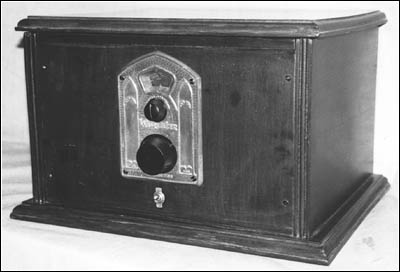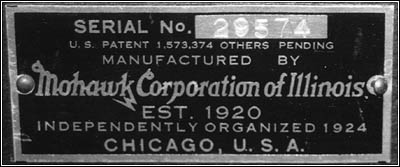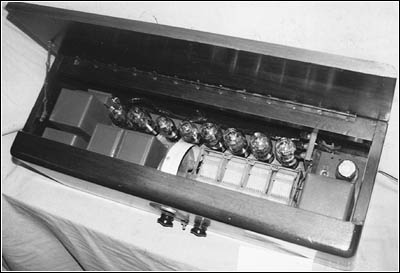Of Old Radios And Related Items--Published Monthly
Jukebox Radios -- Gee Dad, It's a Wurlitzer
BY WALLY WORTH
WEB EDITION
The name Wurlitzer is most often associated with juke boxes, but the company also sold radios. In this article, Wally describes some Wurlitzer radios and tells us who really made them. (Editor)
Recently I had the opportunity to purchase a Wurlitzer radio. The name Wurlitzer intrigued me, and, in spite of the dour description of the set's condition, I bought it.
It was described as coming from a large and diverse collection that had been stored for 20 years or more in a shed and a garage. Unfortunately, the shed and garage burned down, and what the fire didn't ruin, water from the firemen's hoses did. The collection was also exposed to the elements in this condition for a long time, further reducing their value as collector items. However, I like to fix up old radios that are considered beyond repair.
Low Expectations
When the radio arrived, I wasn't expecting much and wasn't disappointed. The brass escutcheon on the front panel read "Wurlitzer," a name that I knew but only from jukeboxes. The metal tag inside the cabinet read "Wurlitzer Co." and "By the AAM Co. NY." I quickly researched both names in the Rider and Gernsback books and found that AAM was the All American Mohawk Corporation of Tonawanda, New York.
Pictures of Mohawk table models and consoles also appear in Alan Douglas' Radio Manufacturers of the 1920s, Volume I. In addition, his book covers the origin of the company and mentions Rauland's All American audio frequency transformers that I collected in years past.
The puzzle started to come together now, and after looking into chassis layouts and cabinet designs, I ventured to place the Wurlitzer in the 1926 era. I also determined that the radio was marketed as the "Navaho" model.
My Wurlitzer Navaho
A front view and an interior view of the Navaho are shown in Figures 1 and 2 As these figures show, the radio is a 6-tube TRF set. The audio output tube can be either a Type 201-A or 71-A. The other five tubes are Kellogg Type 401s, which employ an indirectly heated cathode that permits the filament, or heater, to be powered by alternating current. Unlike conventional tubes, the filament connections are made at the top of the tube by what resembles a grid cap. Figure 2 shows the bus bar wiring and top cap connectors used in the filament circuit of the radio. (The Kellogg Type 401 tube was described in the October 1993 issue of A.R.C.)

Figure 1. A front view of the restored Wurlitzer "Navaho" Model. The large knob is the tuning control and the small knob controls volume. The toggle switch below the escutcheon is the on-off switch.

Figure 2. An interior view of the set shows the 3-section tuning capacitor, the five Kellogg tubes and the Type 71A tube. The two pieces of U-shaped bus bar make the filament connections to the snap-on filament connectors used with the Kellogg tubes. The volume control is located at the rear of the chassis.
Clearly the radio needed a lot of work. Because of the extensive damage to the cabinet, only the front panel could be salvaged, and I had to reconstruct the rest of the cabinet. The bus bar wiring for filament circuit of the Kellogg tubes was in place but several of the snap-on filament connectors were missing. Fortunately, the three-section tuning capacitor and its knob were in good shape.
Construction
The RF coils and AF transformers are housed in copper cans. These components, the audio output transformer and most of the wiring are located under the chassis. One interesting detail is the use of concentric controls for volume and tuning. An inner concentric shaft actuates the volume control and an outer shaft connects to the tuning capacitor. The volume control is located at the rear of the chassis.
The Cherokee
The appearance of my restored Wurlitzer reminded me of another set that I had previously owned a Cherokee model made by the Mohawk Corporation of Illinois. I was unable to make a connection between the All American Mohawk Corporation in New York and the Mohawk Corporation of Illinois. Perhaps some A.R.C. reader can provide an explanation.
A front panel and an interior view of this radio are shown in Figures 3 and 4. Note the similarity in chassis layout to that of the Navaho model. The tube complement differs in that this set uses five Type 01-As and one Type 71-A.

Figure 3. This Mohawk "Cherokee" model bears a strong resemblance to the Wurlitzer "Navaho." From top to bottom, the controls are the on-off switch, tuning and volume.

Figure 4. Except for the tube types, the Cherokee's chassis layout seems identical to the Wurlitzer.
The small knobs at the top and bottom of the escutcheon control the on-off switch and volume respectively. The large knob is the tuning control and the brass escutcheon carries the legend "One Dial."

Figure 5. This close up of the Cherokee's nameplate indicates the manufacturer to be the Mohawk Corporation of Illinois.
A 9-tube Wurlitzer
A few months after I had purchased the Navaho, I saw an ad in A.R.C. for another. Being on a Wurlitzer kick, I bought that one as well.
When the radio arrived, I was surprised by its weight and cabinet style. The cabinet weighs 56 pounds and is 28" long x 9" high. It looks like an oversized Radiola 17. The cabinet is constructed of 3/4-inch walnut and has rounded corners. The back panel is plywood. A front view of the radio is shown in Figure 6. An interior view of the radio in Figure 7 shows a chassis layout that is similar to the Radiola.

Figure 6. This 9-tube AC-operated Wurlitzer is housed in a cabinet that resembles a Radiola 17.

Figure 7. A top view of the 9-tube Wurlitzer shows a chassis layout that looks like a Radiola 17.
The radio uses the following tube types: 26, (4); 27, (2); 71A, (2); and one Type 80 rectifier. The metal nameplate inside the cabinet identifies the set as a "Wurlitzer A.C. Tube Electric Radio." Although it carries the Rudolph Wurlitzer Co. name, the nameplate also reads "Mfd. By A.A.M. Corp." I believe this radio is from the same period as the Navaho.
After talking to some fellow collectors, I believe that the sets are quite rare and I feel fortunate to have them in my collection. I welcome any comments or additional information regarding these or other Mohawk radios.
(Wally Worth, 2 W. Elm Ave., Wollaston, MA 02170)
At age 15, Wally Worth began saving his paper route money to buy parts for 1-tube sets. Then in 1986, fifty years later, he started to collect anything that needed cabinet work. His diverse collecting tastes include crystal and 1920s battery AC sets, as well as transistor multiband, and even novelty sets. He also collects early tubes and both horn and cone speakers.
| [Free Sample] [Books, etc., For Sale] [Subscribe to A.R.C./Renew] [Classified Ads] [Auction Prices] [Event Calendar] [Links] [Home] [Issue Archives] [Book Reviews] [Subscription Information] [A.R.C. FAQ] URL = http://www.antiqueradio.com/Jun02_Jukebox_Wurl.html Copyright © 1996-2002 by John V. Terrey - For personal use only. Last revised: April 27, 2002. For Customer Assistance please contact ARC@antiqueradio.com or call (866) 371-0512 Pages designed/maintained by Wayward Fluffy Publications
Antique Radio Classified |